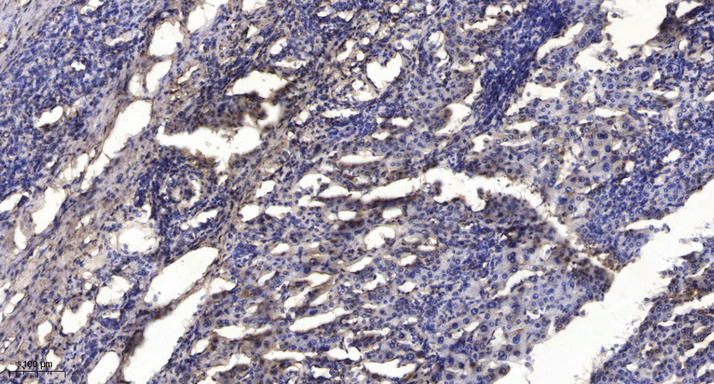SIRT1 (GlcNAc D548) rabbit pAb
- Catalog No.:YP1622
- Applications:WB;ELISA;IHC
- Reactivity:Human;Mouse
- Target:
- SIRT1
- Fields:
- >>Nicotinate and nicotinamide metabolism;>>Metabolic pathways;>>FoxO signaling pathway;>>AMPK signaling pathway;>>Longevity regulating pathway;>>Longevity regulating pathway - multiple species;>>Cellular senescence;>>Glucagon signaling pathway;>>Alcoholic liver disease;>>Amphetamine addiction;>>MicroRNAs in cancer
- Gene Name:
- SIRT1 SIR2L1
- Protein Name:
- SIRT1 (GlcNAc D548)
- Human Gene Id:
- 23411
- Human Swiss Prot No:
- Q96EB6
- Mouse Gene Id:
- 93759
- Mouse Swiss Prot No:
- Q923E4
- Immunogen:
- Synthesized peptide derived from human SIRT1 (GlcNAc D548)
- Specificity:
- This antibody detects endogenous levels of Human,Mouse SIRT1 (GlcNAc D548)
- Formulation:
- Liquid in PBS containing 50% glycerol, 0.5% BSA and 0.02% sodium azide.
- Source:
- Polyclonal, Rabbit,IgG
- Dilution:
- WB 1:500-2000;IHC 1:50-300; ELISA 2000-20000
- Purification:
- The antibody was affinity-purified from rabbit serum by affinity-chromatography using specific immunogen.
- Concentration:
- 1 mg/ml
- Storage Stability:
- -15°C to -25°C/1 year(Do not lower than -25°C)
- Other Name:
- NAD-dependent protein deacetylase sirtuin-1 (hSIRT1;EC 3.5.1.-;Regulatory protein SIR2 homolog 1;SIR2-like protein 1;hSIR2) [Cleaved into: SirtT1 75 kDa fragment (75SirT1)]
- Observed Band(KD):
- 78kD
- Background:
- This gene encodes a member of the sirtuin family of proteins, homologs to the yeast Sir2 protein. Members of the sirtuin family are characterized by a sirtuin core domain and grouped into four classes. The functions of human sirtuins have not yet been determined; however, yeast sirtuin proteins are known to regulate epigenetic gene silencing and suppress recombination of rDNA. Studies suggest that the human sirtuins may function as intracellular regulatory proteins with mono-ADP-ribosyltransferase activity. The protein encoded by this gene is included in class I of the sirtuin family. Alternative splicing results in multiple transcript variants. [provided by RefSeq, Dec 2008],
- Function:
- catalytic activity:NAD(+) + an acetylprotein = nicotinamide + O-acetyl-ADP-ribose + a protein.,cofactor:Binds 1 zinc ion per subunit.,enzyme regulation:Inhibited by nicotinamide. Activated by resveratrol (3,5,4'-trihydroxy-trans-stilbene), butein (3,4,2',4'-tetrahydroxychalcone), piceatannol (3,5,3',4'-tetrahydroxy-trans-stilbene), Isoliquiritigenin (4,2',4'-trihydroxychalcone), fisetin (3,7,3',4'-tetrahydroxyflavone) and quercetin (3,5,7,3',4'-pentahydroxyflavone). RPS19BP1/AROS acts as a positive regulator of deacetylation activity.,function:NAD-dependent deacetylase, which regulates processes such as apoptosis and muscle differentiation by deacetylating key proteins. Deacetylates 'Lys-382' of p53/TP53 and impairs its ability to induce proapoptotic program and modulate cell senescence. Deacetylates TAF1B and thereby represses rDNA transcription by the RNA polymerase I. Involved in HES1
- Subcellular Location:
- Nucleus, PML body . Cytoplasm . Nucleus . Recruited to the nuclear bodies via its interaction with PML (PubMed:12006491). Colocalized with APEX1 in the nucleus (PubMed:19934257). May be found in nucleolus, nuclear euchromatin, heterochromatin and inner membrane (PubMed:15469825). Shuttles between nucleus and cytoplasm (By similarity). Colocalizes in the nucleus with XBP1 isoform 2 (PubMed:20955178). .; [SirtT1 75 kDa fragment]: Cytoplasm . Mitochondrion .
- Expression:
- Widely expressed.
- June 19-2018
- WESTERN IMMUNOBLOTTING PROTOCOL
- June 19-2018
- IMMUNOHISTOCHEMISTRY-PARAFFIN PROTOCOL
- June 19-2018
- IMMUNOFLUORESCENCE PROTOCOL
- September 08-2020
- FLOW-CYTOMEYRT-PROTOCOL
- May 20-2022
- Cell-Based ELISA│解您多样本WB检测之困扰
- July 13-2018
- CELL-BASED-ELISA-PROTOCOL-FOR-ACETYL-PROTEIN
- July 13-2018
- CELL-BASED-ELISA-PROTOCOL-FOR-PHOSPHO-PROTEIN
- July 13-2018
- Antibody-FAQs
- Products Images

- Immunohistochemical analysis of paraffin-embedded human liver cancer. 1, Antibody was diluted at 1:200(4° overnight). 2, Tris-EDTA,pH9.0 was used for antigen retrieval. 3,Secondary antibody was diluted at 1:200(room temperature, 45min).



